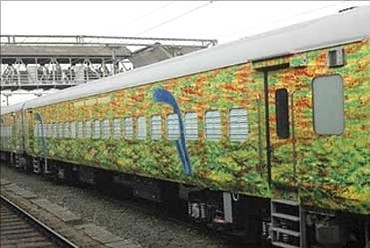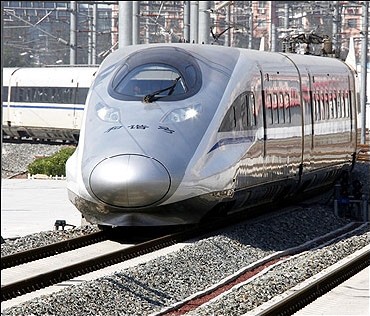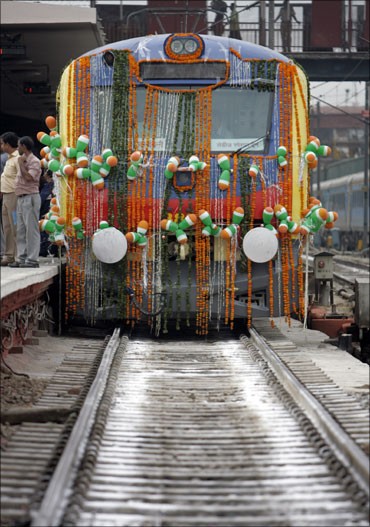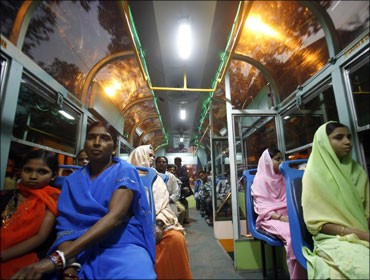Barun Roy in New Delhi
Our poor railway network is a reflection of how we, as a nation, wait for things to happen unlike China that makes things happen.
To date, India, with one of the largest railway networks in the world, doesn't have a single kilometre of railway that can be called high-speed, dedicated to trains running at 200 km or more an hour.
To date, China has 8,358 km of such tracks laid out and in service and 17,000 km more under construction.
Readers may draw their own conclusions. As far as I am concerned, the attitudinal difference of the two nations couldn't be starker.
We keep hoping things will fall in place by themselves some day. They think "some day" isn't good enough when a nation waits to grow, and things must be made to fall in place.
...
A tortoise named Duranto trains
Image: A new high-speed train arrives at the Beijing-South railway stationPhotographs: David Gray/Reuters
The railways are just one example of how they're forcing things to fall in place, instead of simply waiting for them to happen.
Our fastest trains still can't best 160 km per hour. Their latest bullet between Shanghai and Beijing runs at 300 km per hour, bringing the two cities, 1,318 km apart, within five hours of each other.
We may have as many Durantos as we like, but, in today's speeding world, these are nothing but a bunch of tortoises in disguise, let loose to fool a gullible nation.
The hares are much wiser now and slow and steady is no longer a race-winning quality.
...
A tortoise named Duranto trains
Photographs: Fayaz Kabli/Reuters
We may not bother because even a bullock cart is capable of getting us to our destination, some day. But we aren't in bullock-cart India.
If we wish to be seen as a dynamic economy, we have to be seen to be moving faster too, since economic growth, after all, is a matter of overcoming time and space barriers to expand opportunities and benefits.
Growth scenarios change when distances shrink and airways alone aren't a good enough substitute for efficient surface transportation simply because of the breadth of physical ground the latter is able to cover along the way.
This is something we don't seem to comprehend. There's no better way to bring growth to virgin or little-exploited countryside, and transform it into an integrated economic hinterland, than to build a full-blown network of speedier roads and railways.
...
A tortoise named Duranto trains
Photographs: Jayanta Shaw/Reuters
Our highways, for the most part, are like dressed-up country roads, where even cyclists and pedestrians demand the right of way. Our railways haven't advanced much beyond their colonial past and hardly run on time.
Of course, we have half a dozen high-speed rail corridors in mind, but for now they're only visions.
Let's be happy with that, calling up mental images of our very own bullets hurtling across our landscape at 200 km or 350, even 500, if you like an hour. Isn't mind travel the best form of travel for the lazy, where speed has no limit?
...
A tortoise named Duranto trains
Image: China's high speed trainsChina is obsessive about reducing distances and overcoming the vastness of its geographic space.
It has had at least six speed increases on its trains nationwide since 1997. In the Beijing-Shanghai section itself, travel time has come down from 14 hours in 2001 to nine hours and 48 minutes in 2006.
Now, with 300 km-per-hour bullets in service, one can make the journey in less than five hours. It reflects a degree of keenness to improve, to bring the nation closer together in every possible way, which India has so far been unable to show.
Actually, two sets of high-speed trains are being introduced on the Beijing-Shanghai route, 90 trains in all.
...
A tortoise named Duranto trains
Image: A high-speed train travels on the newly built Shanghai-Hangzhou railway in ShanghaiPhotographs: Aly Song/Reuters
Sixty-three trains will run at 300 km per hour, covering the distance in four hours and 48 minutes, while 27 trains will run at 250 km per hour with a travel time of seven hours and 56 minutes.
What does it mean for travellers? A train every five minutes during daily peak hours! And when one remembers that all the 136 existing trains on this route, running on separate tracks, are also going to stay, the connectivity assumes the dimensions of a virtual metro network.
Connectivity at increasing levels of efficiency is the name of the game, and China has been at it heart and soul with its railways since 2005.
...
A tortoise named Duranto trains
Image: A man crosses a railway bridge on Teesta River near SiliguriPhotographs: Rupak De Chowdhuri/Reuters
Its aim is to have 120,000 km of total railways by 2015, of which 45,000 km will be high-speed, including 8,870 km of railways with top speeds of 350 km per hour.
Will this put us into introspection? Don't even ask. Introspection is not in our nature. Besides, the moment China and India are compared, our nationalist bristles begin to stand up and the dictatorship-versus-democracy arguments start flying.
All other questions become moot, even harmless ones like why do we keep introducing more and more lumbering trains on the same old tracks that haven't been renewed for ages? Is it progress? Doesn't efficiency matter? Is it forbidden in a democracy?








article